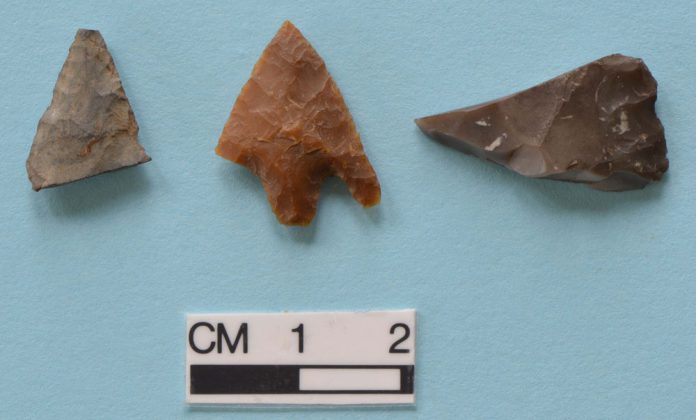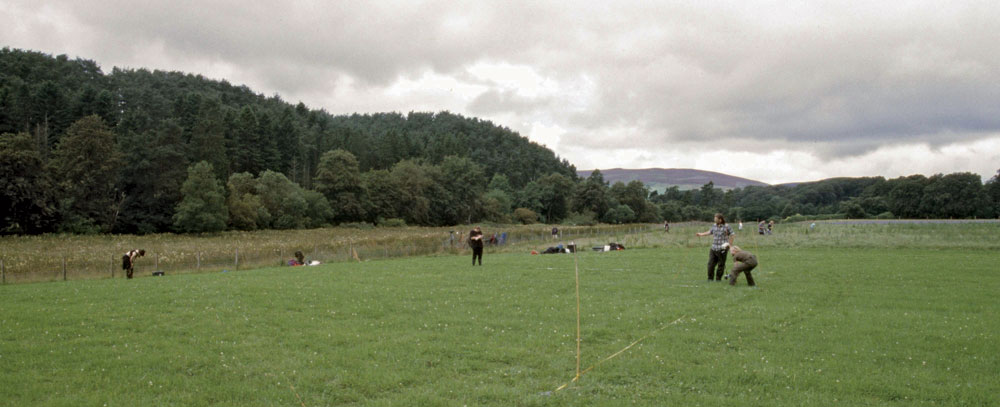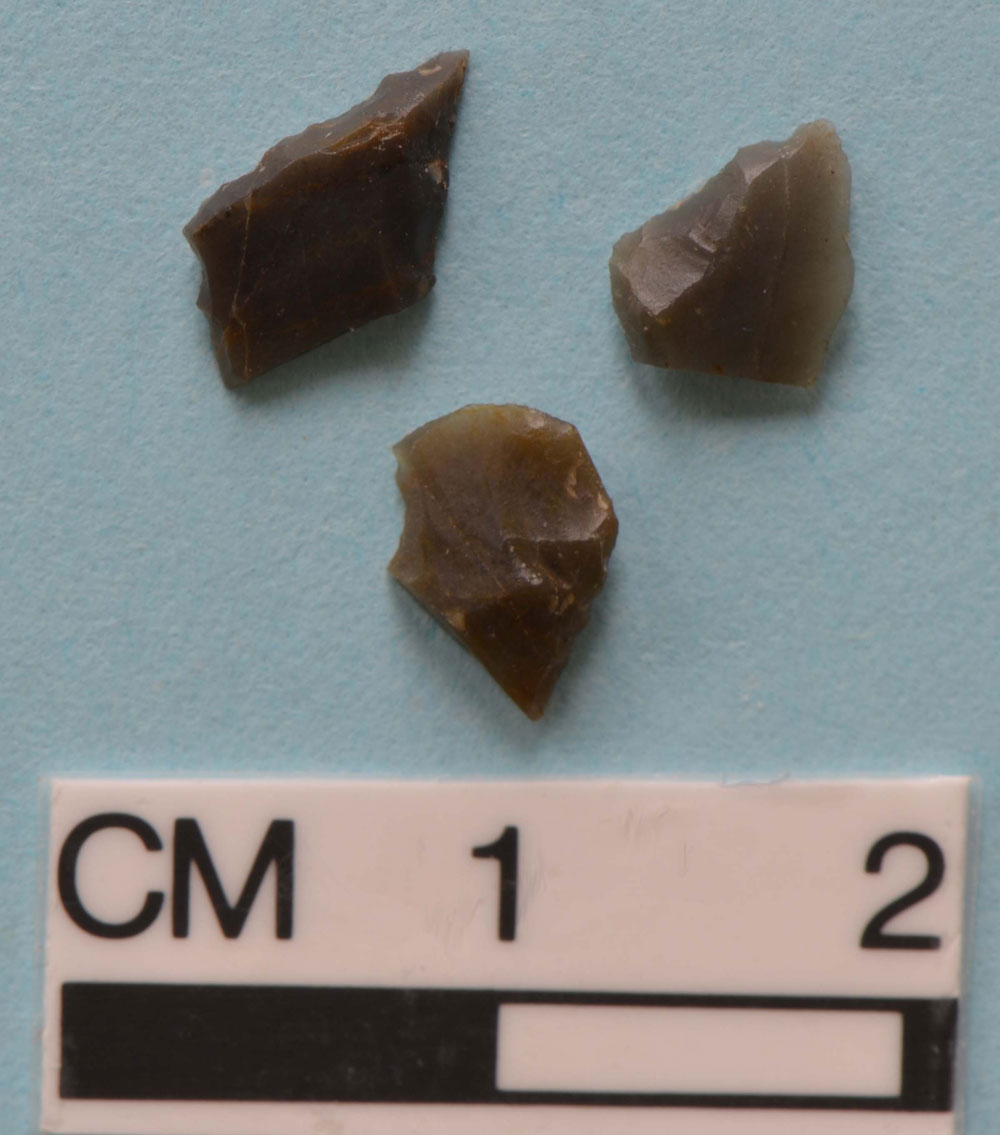A chronologically mixed lithic assemblage
During the subsequent investigation of the Garvald Burn site, a chronologically mixed lithic assemblage of 1,562 pieces was recovered. The site as a whole revealed few tangible features, but in one small part of the investigation area, a number of features were discovered, including a hearth and a windbreak. This area also yielded a lithic assemblage of 587 pieces, dominated by chert. This assemblage includes diagnostic typo-technological elements that indicate a Late Mesolithic date, and radiocarbon-dating of a charcoal sample from a post-hole within the windbreak supports this (4350–4000 cal BC). After careful consideration and consultation with Historic Scotland, it was agreed that this assemblage and its context deserved more detailed scrutiny and publication. Although GUARD Archaeology were not involved in this project, we are very pleased to publish the results of the new post-excavation research by Torben Bjarke Ballin and Chris Barrowman in our journal Archaeology Reports Online (ARO).
A palimpsest of landscape use
The site at Garvald Burn, as well as its small Late Mesolithic lithic assemblage, were both the products of a long list of factors. One of the main ones, in terms of site formation, is the fact that the settlers were hunter-gatherers, and a site was selected as the focus of a visit on the basis of how that location would fit into a particular social group’s mobile economic strategy.
General concerns would have been where prey could be encountered, vegetable matter gathered, and which sites would offer good fishing. The location of river courses and small streams was of utmost importance, as these topographic features offered means of transport, fishing grounds, as well as drinking water for animals and people. The fact that these topographic features may have been of equal importance to people throughout prehistory – it should be borne in mind that hunting, fishing and gathering also took place in post Mesolithic times – explains why palimpsests formed at sites like Garvald Burn.
The specific layout of the camp at Garvald Burn indicates that the social group settling at this location may have been a numerically small one. A small domestic hearth was identified (much smaller for instance than the substantial hearth revealed at the permanent Mesolithic settlement at Howick in Northumberland), associated with a relatively ‘flimsy’ structure thought to be an expedient windbreak. Sheltered by this structure, and immediately next to the hearth, a relatively dense knapping floor was identified, associated with primary production, retooling and other tool use. The expedient character of the features, as well as the numerically small size of the lithic assemblage and its composition, suggests that this may have been a transit camp for a small group of people, possibly even for small task group consisting of one or two hunters.
The composition of the assemblage is consistent with this scenario, with the primary debris indicating the production of microblade blanks for the production of microliths; discarded microliths suggest retooling activities; and the scrapers (one of which was clearly used to process hard materials) and the burin may have been used in connection with the production or repair of implements in wood, bone or antler, such as for example slotted bone points for the microliths, arrowshafts, etc.
A picture of social exchange
The lithic assemblage from Garvald Burn is the product of a particular technological tradition and its raw material procurement strategy, which is examined in great detail in Chris and Torben’s report.
Within Late Mesolithic southern Scotland, the composition of assemblages varied somewhat, depending on a given site’s specific location. Chert was abundantly available throughout the region, but there are no indications of chert having been associated with any symbolic values, or that it was exchanged outside the immediate social territory.
In Late Mesolithic southern Scotland, the same seems to have been the case regarding the procurement of coastal flint, which was exchanged along the rivers, but only to provide raw material for groups living relatively near the coasts. Where flint was readily available, it was favoured at the expense of chert, due to its ability to form sharp, strong and durable working-edges.
This resulted in a procurement strategy, with flint dominating along the eastern and western seaboards, but with chert dominating the central parts of southern Scotland, where flint, in logistical terms, became too expensive. On the coast, e.g. Low Clone and Barsalloch in Dumfries and Galloway, Late Mesolithic groups almost exclusively exploited flint; in the interior e.g. Glentaggart and Climpy in South Lanarkshire, chert was used equally exclusively; and at the mid-point, such as at Starr and Smittons in the interior parts of East Ayrshire and Dumfries and Galloway, chert and flint were used in roughly equal measures. The assemblage from Garvald Burn, which is located approximately 80-100 km from the eastern and western shores, and roughly 30 km from the Firth of Forth, is almost exclusively composed of chert, which was probably gathered from the banks of the burn.
The full results of this research, which was funded by Historic Scotland, ARO15: Chert artefacts and structures during the final Mesolithic at Garvald Burn, Scottish Borders, (PDF, 2,961KB) has just been published and is now freely available to download.
ARO website – www.archaeologyreportsonline.com.




